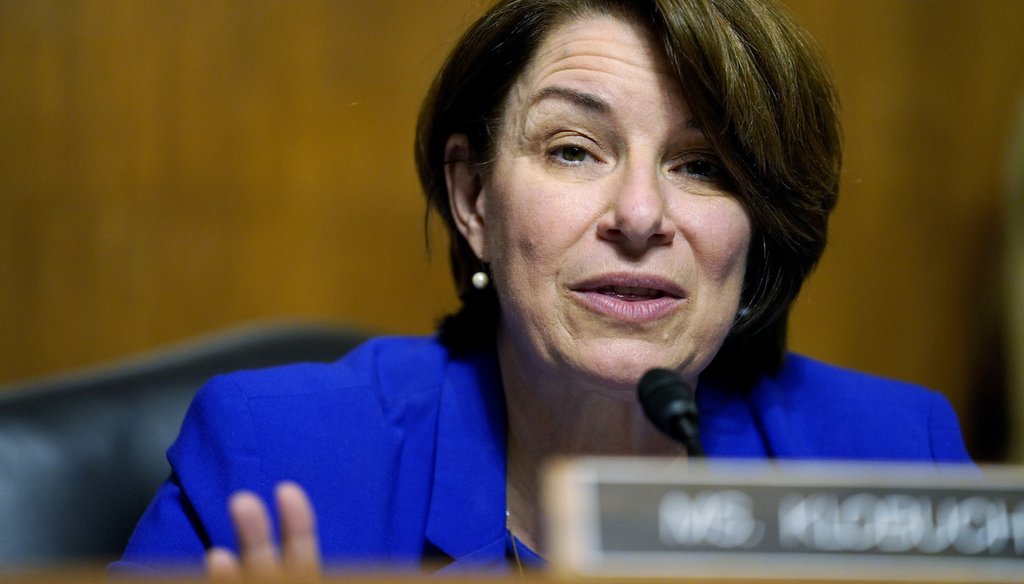Get PolitiFact in your inbox.

Sen. Amy Klobuchar, D-Minn., speaks during a hearing of the Senate Judiciary Subcommittee on Competition Policy, Antitrust, and Consumer Rights, on Sept. 21, 2021. (Pool via AP)
How unusual would it be to create a filibuster carve-out for voting rights?
If Your Time is short
• The Senate filibuster rules typically mean that you need 60 votes to proceed to an actual vote on any matter. Klobuchar says there are 160 exceptions.
• Klobuchar cited independent research that documents roughly that many exceptions, including well-known examples like court and cabinet nominee confirmations and budget reconciliation.
• Other examples from the research are more obscure and might not be considered significant exceptions.
• Klobuchar wants an exception for voting rights legislation. That would be a much more significant type of legislation than what typically has gotten an exception.
Democrats say that Republican efforts to change the laws on voting and elections could suppress voting and even overturn election results. They’ve responded with a bill of their own to establish federal standards on voting.
The Freedom to Vote Act is pending in the Senate, but it’s facing unanimous Republican opposition in the evenly divided chamber. That means it doesn’t have enough support to reach the 60-vote threshold required to clear a filibuster and proceed to a final vote under typical Senate rules.
This reality has led some Democrats to call for either ending the filibuster or at least carving out an exception to the filibuster rules to be used when considering voting-related legislation. Democrats argue that election rules are such a core facet of democracy that their protection shouldn’t be able to be blocked by a minority of senators.
Sen. Amy Klobuchar, D-Minn., said she’d personally favor ending the filibuster. But she also made a case to senators who are more protective of the filibuster: that a carve-out for voting rights would be justified, based on historical precedent.
"I would abolish the filibuster, but even if you keep the filibuster in place, over time there have been 160-some carve-outs to the filibuster," Klobuchar said on NBC’s "Meet the Press" on Dec. 5. "The rules have changed over and over."
We immediately thought of a few examples of such carve-outs. They include executive-branch and judicial confirmations — notably, for Supreme Court nominees — which have shifted to simple-majority passage during the past decade. We also thought of budget reconciliation rules, which allow a simple majority to pass fiscal-related bills that follow a congressionally passed budget blueprint. (The Biden administration was able to pass the American Rescue Plan, a coronavirus relief bill, using reconciliation earlier this year, and it hopes to do the same with the Build Back Better bill that expands the social safety net.)
Another, more obscure category involves efforts to overturn administrative rules under the Congressional Review Act.
Still, we certainly couldn’t think of 160 examples, so we decided to take a closer look at Klobuchar’s assertion.
We found that Klobuchar’s number was roughly accurate, although the kinds of carve-outs she was referencing are different from what would be needed to create a carve-out for voting rights.
Where does the figure come from?
As support for the statistic she offered on "Meet the Press," Klobuchar’s office pointed to research by Molly Reynolds, a senior fellow in governance studies at the Brookings Institution. Specifically, Klobuchar’s office pointed to data from a chapter in Reynolds’ 2017 book, "Exceptions to the Rule: The Politics of Filibuster Limitations in the U.S. Senate."
In the book, Reynolds collected 161 examples of the Senate establishing work-arounds to the ordinary 60-vote requirement to push past a filibuster.
Reynolds confirmed to PolitiFact that the number Klobuchar cited accurately reflects the research. However, she and other experts on Senate procedure noted some caveats.
How narrow are previous carve-outs?
Not all carve-outs are equal. Reynolds said that many of the exceptions, such as those involving arms sales to foreign countries, are not as sweeping and significant a category as voting rights.
"In some cases, very similar procedures are counted separately," Reynolds told PolitiFact. For instance, she said, the Arms Export Control Act has several related but distinct exceptions for measures on reviewing proposed arms sales. Reynolds counted each of these as separate exceptions, but she said one could reasonably group them together, producing a much smaller number of exceptions than 161.
In addition, many of the simple-majority provisions that make up that total "simply force symbolic votes rather than making actual policy changes," she said.
Finally, some of the 161 provisions have never become operational, while others were designed to be temporary and have lapsed.
How are carve-outs created?
In order to enact a voting-rights carve-out, senators would have to use the same process that was used to make judicial and executive branch appointments simple-majority votes during the past decade. It’s a multi-step process that has sometimes been called the "nuclear option."
Essentially, the majority leader would need to offer a "point of order" stating that a simple-majority vote is called for on the current question. This would be rejected by the chair based on precedent, then immediately appealed. This would trigger a simple-majority vote on whether to overturn the chair’s ruling. Once that simple majority is achieved, the new vote threshold would become the precedent going forward.
While Democrats don’t yet have the 51 votes to support a carve-out for voting rights, this scenario is the most realistic one for them to use to create a simple-majority vote for voting rights.
However, this was not the process used for the vast majority of the 161 prior examples.
Rather, most of those 161 examples were created by passage and enactment of a statute, or ordinary law. This means that, at some point, most of these 161 exceptions themselves had to pass a 60-vote threshold in the Senate.
How feasible would it be to enact a carve-out?
The odds of enacting a carve-out are long, given the reluctance of a few Democrats (and all Republicans) to get on board. But it’s not impossible, experts said.
"When the political and policy incentives are aligned, the Senate has shown a willingness to write new procedures protecting certain legislation from a filibuster," Reynolds said.
She said one of the most common reasons to enact a simple-majority vote occurs when Congress wants to avoid blame for making a politically tough decision. In that scenario, leaders decide that a simple-majority vote is the most painless way to get it done.
In fact, this phenomenon has been playing out in recent days, as congressional leaders search for a way to lift the debt ceiling — a move that is necessary for financial stability but which can be used by challengers as a way to paint those who voted for the debt increase as profligate spenders.
Still, if a carve-out for voting rights is enacted, the distinction between a carve-out and total filibuster reform may one day disappear, said Josh Ryan, a Utah State University political scientist and specialist in Senate procedure.
"You could easily imagine each new Senate majority carving out additional exceptions for authorizing legislative topics," leaving little if anything still covered by the filibuster, Ryan said.
Our ruling
Klobuchar said, "Even if you keep the filibuster in place, over time there have been 160-some carve-outs to the filibuster."
This number is supported by academic research, though there are important differences between what Klobuchar is seeking for the voting-rights bill and what most of the 160-odd prior examples involved.
Many of the past examples are significantly less sweeping than voting rights, and the vast majority had to clear a 60-vote threshold at some point on their way to being enacted, unlike the voting rights carve-out being proposed.
The statement is accurate but needs clarification or additional information, so we rate it Mostly True.
Our Sources
Amy Klobuchar, interview on NBC’s "Meet the Press," Dec. 5, 2021
Molly Reynolds, "Exceptions to the Rule: The Politics of Filibuster Limitations in the U.S. Senate," 2017
Roll Call, "House passes debt limit process, Medicare cuts delay bill," Dec. 7, 2021
Email interview with Josh Ryan, Utah State University political scientist, Dec. 8-9, 2021
Email interview with Molly Reynolds, senior fellow in governance studies at the Brookings Institution, Dec. 8-9, 2021
Browse the Truth-O-Meter
More by Louis Jacobson
How unusual would it be to create a filibuster carve-out for voting rights?
Support independent fact-checking.
Become a member!
In a world of wild talk and fake news, help us stand up for the facts.










































